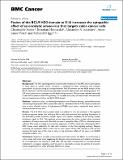Fusion of the BCL9 HD2 domain to E1A increases the cytopathic effect of an oncolytic adenovirus that targets colon cancer cells
Abstract
Background: The Wnt signaling pathway is activated by mutations in the APC and beta-catenin genes in many types of human cancer. beta-catenin is stabilized by these mutations and activates transcription in part by acting as a bridge between Tcf/LEF proteins and the HD2 domain of the BCL9 coactivator. We have previously described oncolytic adenoviruses with binding sites for Tcf/LEF transcription factors inserted into the early viral promoters. These viruses replicate selectively in cells with activation of the Wnt pathway. To increase the activity of these viruses we have fused the viral transactivator E1A to the BCL9 HD2 domain. Methods: Luciferase assays, co-immunoprecipitation and Western blotting, immunofluorescent cell staining and cytopathic effect assays were used to characterize the E1A-HD2 fusion protein and virus in vitro. Growth curves of subcutaneous SW620 colon cancer xenografts were used to characterize the virus in vivo. Results: The E1A-HD2 fusion protein binds to beta-catenin in vivo and activates a Tcf-regulated luciferase reporter better than wild-type E1A in cells with activated Wnt signaling. Expression of the E1A-HD2 protein promotes nuclear import of beta-catenin, mediated by the strong nuclear localization signal in E1A. Tcf-regulated viruses expressing the fusion protein show increased expression of viral proteins and a five-fold increase in cytopathic effect (CPE) in colorectal cancer cell lines. There was no change in viral protein expression or CPE in HeLa cells, indicating that E1A-HD2 viruses retain selectivity for cells with activation of the Wnt signaling pathway. Despite increasing the cytopathic effect of the virus in vitro, fusion of the HD2 domain to E1A did not increase the burst size of the virus in vitro or the anti-tumor effect of the virus in an SW620 xenograft model in vivo. Conclusion: Despite an increase in the nuclear pool of beta-catenin, the effects on viral activity in colon cancer cells were small, suggesting that factors acting downstream of beta-catenin are limiting for viral replication and toxicity in these cells. The approach of fusing E1A to a protein domain implicated in oncogenic signaling could be used to selectively increase the activity of oncolytic viruses targeting several other pathways defective in cancer.
Citation
Fuerer , C , Homicsko , K , Lukashev , A N , Pittet , A-L & Iggo , R D 2006 , ' Fusion of the BCL9 HD2 domain to E1A increases the cytopathic effect of an oncolytic adenovirus that targets colon cancer cells ' , BMC Cancer , vol. 6 , pp. 236 . https://doi.org/10.1186/1471-2407-6-236
Publication
BMC Cancer
Status
Peer reviewed
ISSN
1471-2407Type
Journal article
Description
Swiss Cancer League, Swiss National Science Foundation and SNSF NCCR Molecular Oncology ProgrammeCollections
Items in the St Andrews Research Repository are protected by copyright, with all rights reserved, unless otherwise indicated.

